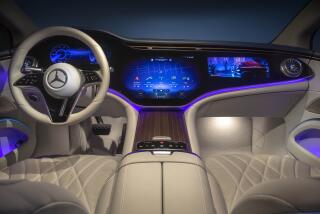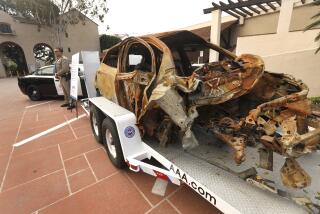Vehicle ‘infotainment’ systems out of sync with drivers’ devices
Chris Knox braces for frustration every time he steps into his new Ford F-150 truck.
Mechanically, the pickup is perfect. But the MyFord Touch communication and entertainment system constantly seizes up as Knox tries to make hands-free calls from his iPhone 5.
“Sometimes it works for two weeks, and then I get into the truck and it just stops,” said Knox, a Torrance driver’s education teacher. “I am constantly doing the master reset on the system.”
The latest in-dash “infotainment” systems are turning into a giant headache for drivers. Problems with phone, entertainment and navigation functions were the biggest source of complaints in the latest J.D. Power & Associates survey of new-car quality, easily outstripping traditional issues such as fit and finish and wind noise.
Much of the problem lies in the disconnect between product cycles for cars and smartphones. The technology in cars, which take years to come to market, can’t keep pace with relentless smartphone updates.
The compatibility issues highlight an industry debate: Should cars come with their own communication and navigation systems? Or should they simply mirror smartphones on their dashboard screens, tapping into the constantly updated app environment?
Meanwhile, car companies are spending millions of dollars developing interfaces, voice recognition software and navigation systems. Many of these functions either already come loaded on phones or can be downloaded at the swipe of a finger. Honda Motor Co., for instance, charges $2,000 for a satellite-linked navigation and traffic system on the premium version of its popular Accord sedan. But Waze, a division of Google Inc., provides the same functionality in a free app.
Automakers are attacking in-dash technology in a piecemeal way that could take years to sort out. Think of it as a modern version of the old Betamax versus VHS battle over videocassette recorder formats.
Ford Motor Co. has its own system. Apple Inc. is working with one set of automakers to design an interface that works better with its iPhone line. Some of the same car companies and others have joined the Car Connectivity Consortium, which is working with the major Android phone brands to develop a different interface.
All of this is complicated by the growing role of smartphones in daily life.
“People today bond more with their smartphones than their car,” said Tom Mutchler, the senior engineer at the Consumer Reports Auto Test Center. “Car companies are going to have to live up to the expectations that come with that.”
Some car brands, including Ford and Lincoln, are sticking to building their own systems into cars.
“For the safety and overall experience for our customers, we think allowing developers to create apps that will work with our system, using our specifications, is the best way to go,” said Jim Buczkowski, director of electrical and electronics systems at Ford Research and Innovation.
He’s not a fan of handing control of these functions to a smartphone, because many of the features in the vehicle’s infotainment system “are very deeply integrated into the overall vehicle.”
“It’s arguable that a phone does all just as well or better,” Buczkowski said. “And if you forget your phone, you’re out of luck.”
Knox, the F-150 driver, isn’t worried about forgetting his phone — he’s irritated that he can’t use it in his truck. In fact, he’s asked Ford to take the pickup back, a request the automaker has denied. Ford plans a software update this year.
Knox and other consumers would rather see automakers stick to making cars and leave communications technology to the experts.
“Google or Apple could do a better job, not Ford,” he said.
The static nature of the car-based systems creates compatibility problems down the road, said Pavan Mathew, a Detroit-based executive who heads Automotive Telematics for Telefonica, the European telecommunications giant.
“That’s the industry debate — built-in versus brought-in,” Mathew said. “When you have an embedded system, that vehicle will have two or three owners over 10 or 12 years. But you are changing your phone every other year, and the top-of-mind apps are continuously changing.”
That’s why Chevrolet, Mini and some other automakers are starting to offer screens that mirror apps from a smartphone. To cut back on distracted driving, the systems will work only with apps that are safe for automotive use.
Those types of mirrored systems will become more common in new models starting next year, said Jorg Brakensiek, the technical work group chairman of the Car Connectivity Consortium, which includes major automakers such as Honda, Toyota Motor Corp. and Hyundai Motor Co., as well as Samsung Electronics Co., HTC Corp. and other phone manufacturers.
The group’s new MirrorLink car/phone interface system will start to show up in cars next year.
“We recognized that users were frustrated when their smartphones became worthless when they stepped into the car, and that the infotainment system in the car was generations behind their phone,” Brakensiek said.
Some electronics companies are already selling mirror-type systems in aftermarket devices, including the $399 AppRadio from Pioneer, which can be installed in older vehicles or in cars that didn’t come equipped with embedded infotainment systems.
The auto industry is going through a series of gyrations that will favor this mirrored technology for about the next five years, said Di-Ann Eisnor, vice president of platforms and partnerships at Waze, the car navigation app division of Google. The main advantage for consumers, she said, will be lower cost.
But the next generation of in-car technology will get much more interesting, with embedded systems making a comeback of sorts, in more sophisticated form.
Such systems may focus on collecting data that only the car can provide — and transferring it to Web-based systems to large numbers of drivers. If cars signaled that their windshield wipers were on, for instance, that information could be fed into a navigation system that could warn other drivers of a rainstorm ahead.
Or your car could tell an app on your phone how much gas you have left in the tank, so the app could find the cheapest gas station on your route.
The electronics could also trigger on-board cameras to take instant photos if sensors detect that the car was about to be in a crash, enabling drivers to document the sequence of events leading to the accident.
“Right now, it is just one way, with your phone connected to your car,” Eisnor said, “but the really interesting things begin to happen when the information goes from the car to your phone.”
twitter: @latimesjerry







